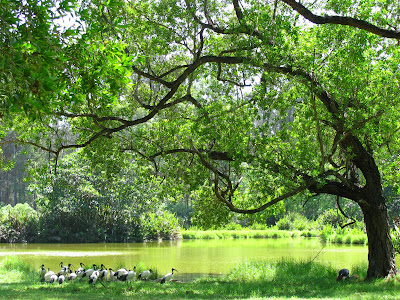Haller Park, Mombasa
For me, a trip to Mombasa Haller Park Haller Park

 |
| You can see the excavation site (derelict quarry) behind... |
Dr. Haller experimented with tree planting and found that in the severely
barren conditions only casuarina equisetifolia survived and thus willy nilly the initial mitigation measure began as a monoculture plantation. As the next step, millipedes were introduced to feed on casuarina needles that fell on to the quarry floor and to turn them into humus.
At a conference organized on the occasion of Nature
 |
| Nile crocodiles in Reptile Park |
 |
| Lily pond |
 |
| Eland, the largest antelope... looks rather like cattle |
In my ecology studies I had learnt of development of ecological seres, how flora and fauna evolve naturally on barren land, volcanic islands or in ponds, the succession of species – of plants, the elbowing and edging out of certain weaker species by the dominant ones, the competition and struggle, the establishment of the predominant ones, and finally the climax vegetation, the survival of the fittest. It is one thing to observe and extrapolate natural progression, entirely another for man to replicate the same in a manner of reverse engineering. Such instances of ecological rehabilitation of spent spaces, few and far between as they are, are a testimony to man’s ingenuity and give hope that if man decides, he can restore lost ecosystems.


I had been to Haller Park
 |
| Who would believe this was once a dust and debris aridity? |





great stuff, took me bck to my trip there which was at a different time. the pics are lovely. sri
ReplyDeleteNever knew such a park exists in Mombasa ..is part of my trip next time..the pics were superb ..got carried away with the pHotos more than the writing actually..
ReplyDeleteAll credit to Dr Haller for embarking on such a wonderful exercise and thanks to you and your blog that i could visualise myself in the park enjoying the beauty, rather renewed beauty. Hope we can take some leaf out of this and instead of fighting over the illegal mining and forgetting thereafter we too ensure that such activities are encouraged from the Govt as well.
ReplyDeleteI enjoy reading your blogs and looking at the pictures of nature. When are you putting it in the form of a book?
ReplyDeleteExquisite pictures, beautiful writing, a poem to Mother Nature. This is the best Nature blog I have read!
ReplyDeleteAlways enjoy reading your posts Padmaja. Keep them coming.
ReplyDeleteThis is a article loaded with information for novice and very experienced environmentolist. I loved the way you have described the transformation and the experiment with plantation.
ReplyDeleteIt takes you in the location and the snaps are bliss to eyes.
It is nice we have enviroment lovers and protectors, and good you spread the message with your words.
all the best.
Truly Inspiring story. We ourselves are working on a project in the Nilgiris to replant shola forests in patches given by private estates partly as a social responsibility initiative and partly as an educational program for kids across the Nilgiris. Certainly inspired by Dr. Haller's work.
ReplyDeletepadmaja aatya your article is so very gud. The pictures are very beautiful and your writing is very nice. It is so effective as if you are just seeing it in front of you.
ReplyDeletego, hug your parents,
ReplyDeletehug your kids,
hug a tree.
hug the animals,
hug the wild,
hug wild!
hug is the last lingering
horrible hunger there is!
-shankar
Lovely pics, and beautifully descriptive blog ... way to go! Armin
ReplyDelete